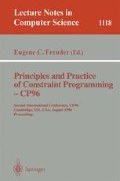Abstract
In a recent paper, the concept of “free amalgamation” has been introduced as a general methodology for interweaving solution structures for symbolic constraints, and it was shown how constraint solvers for two components can be lifted to a constraint solver for the free amalgam. Here we discuss a second general way for combining solution domains, called rational amalgamation. In praxis, rational amalgamation seems to be the preferred combination principle if the two solution structures to be combined are “rational” or “non-wellfounded” domains. It represents, e.g., the way how rational trees and rational lists are interwoven in the solution domain of Prolog III, and a variant has been used by W. Rounds for combining feature structures and hereditarily finite non-wellfounded sets. We show that rational amalgamation is a general combination principle, applicable to a large class of structures. As in the case of free amalgamation, constraint solvers for two component structures can be combined to a constraint solver for their rational amalgam. From this algorithmic point of view, rational amalgamation seems to be interesting since the combination technique for rational amalgamation avoids one source of non-determinism that is needed in the corresponding scheme for free amalgamation.
This work was supported by a DFG grant (SSP “Deduktion”) and by the EC Working Group CCL, EP6028.
Preview
Unable to display preview. Download preview PDF.
References
P. Aczel, “Non-well-founded Sets,” CSLI Lecture Notes 14, Stanford Univ., 1988.
H. Ait-Kaci, A. Podelski, and G. Smolka, “A feature-based constraint system for logic programming with entailment,” Theoretical Comp. Science 122, 1994, pp.263–283.
F. Baader and K.U. Schulz, “On the Combination of Symbolic Constraints, Solution Domains, and Constraint Solvers,” in: Proceedings CP'95, U.Montanari, F.Rossi (Eds.), Springer LNCS 976, pp. 380–397.
F. Baader, J. Siekmann, “Unification Theory,” in D.M. Gabbay, C. Hogger, and J. Robinson, Editors, Handbook of Logic in Artificial Intelligence and Logic Programming, Oxford University Press, Oxford, UK, 1994, pp. 41–125.
R. Backofen and R. Treinen, “How to Win a Game with Features,” in Constraints in Computational Logics, Proc. CCL'94, J.-P. Jouannaud (Ed.), Springer LNCS 845, 1994, pp. 320–335.
A. Colmerauer, “Equations and inequations on finite and infinite trees,” in: Proc. 2nd Int. Conf. on Fifth Generation Computer Systems, 1984, pp.85–99.
A. Colmerauer, “An introduction to PROLOG III,” C. ACM 33, 1990, pp. 69–90.
B. Courcelle, “Fundamental Properties of Infinite Trees,” Theoretical Computer Science 25, 1983, pp. 95–169.
D.M. Gabbay, “An Overview of Fibred Semantics and the Combination of Logics,” to appear in Proceedings of the First International Workshop “Frontiers of Combining Systems” FroCoS'96, F. Baader and K.U. Schulz, Eds., Kluwer Academic Publishers, 1996.
S. Kepser and K.U. Schulz, “Combination of Constraint Systems II: Rational Amalgamation,” long version of this paper, available via anonymous ftp from ftp.cis.uni-muenchen.de (directory “schulz”, file name “RationalAmalgamation.ps.Z”).
M. J. Maher, “Complete axiomatizations of the algebras of finite, rational and infinite trees,” in: Proceedings of Third Annual Symposium on Logic in Computer Science, LICS'88, pp. 348–357, Edinburgh, Scotland, 1988.
A.I. Mal'cev, “The Metamathematics of Algebraic Systems,” volume 66 of Studies in Logic and the Foundation of Mathematics, North Holland, Amsterdam, London, 1971.
J. Pfalzgraf, “Logical Fiberings and Polycontextural Systems,” In Fundamentals of Artificial Intelligence Research, Ph. Jorrand and J. Kelemen, Eds., Springer LNCS 535 (1991).
J. Pfalzgraf and K. Stokkerman, “On Robotics Scenarios and Modeling with Fibered Structures,” In Springer series Texts and Monographs in Symbolic Computation, Automated Practical Reasoning: Algebraic Approaches, J. Pfalzgraf and D. Wang, Eds., Springer Verlag, 1994.
W.C. Rounds, “Set values for unification based grammar formalisms and logic programming,” Research Report CSLI-88-129, Stanford, 1988.
G. Smolka, R. Treinen, “Records for Logic Programming,” J. of Logic Programming 18(3) (1994), pp. 229–258.
Author information
Authors and Affiliations
Editor information
Rights and permissions
Copyright information
© 1996 Springer-Verlag Berlin Heidelberg
About this paper
Cite this paper
Kepser, S., Schulz, K.U. (1996). Combination of constraint systems II: Rational amalgamation. In: Freuder, E.C. (eds) Principles and Practice of Constraint Programming — CP96. CP 1996. Lecture Notes in Computer Science, vol 1118. Springer, Berlin, Heidelberg. https://doi.org/10.1007/3-540-61551-2_81
Download citation
DOI: https://doi.org/10.1007/3-540-61551-2_81
Published:
Publisher Name: Springer, Berlin, Heidelberg
Print ISBN: 978-3-540-61551-4
Online ISBN: 978-3-540-70620-5
eBook Packages: Springer Book Archive

